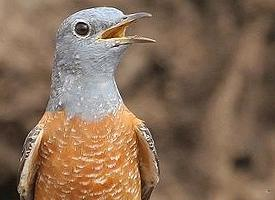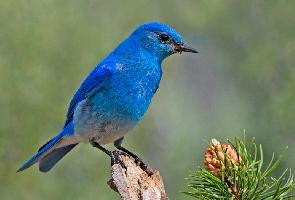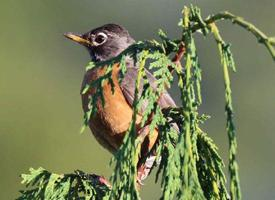
Description de l'animal
The Common Rock Thrush (Monticola saxatilis), a member of the thrush family (Turdidae), is a small, yet captivating bird renowned for its striking plumage and melodious song. This species exhibits a notable sexual dimorphism, with males and females sporting distinctly different color patterns, making them easily distinguishable from one another.Adult males are particularly eye-catching during the breeding season, adorned with a striking combination of colors. Their upper parts are characterized by a deep blue-gray hue, which seamlessly transitions into a vivid orange or rust color on the lower breast and belly. This vibrant contrast is further accentuated by a white belly and undertail coverts, creating a visual spectacle. The wings and tail maintain a darker, slate-gray tone, providing a subtle backdrop to the bird's more vivid colors. The male's face is marked by a distinct white supercilium (eyebrow) that stands out against its darker head, adding to its charismatic appearance.
Females and juveniles, on the other hand, exhibit a more subdued color palette. Their upper parts are primarily a dull brown, speckled with darker spots that provide a camouflaged appearance against rocky outcrops and terrain. The underparts are lighter, often a pale orange or buff, with the same speckled pattern extending from the chest to the belly, aiding in their concealment from predators.
Common Rock Thrushes are relatively small birds, measuring about 20-23 cm in length, with a wingspan that ranges from 33 to 38 cm. Their size, however, does not detract from their presence, especially when males are in full song. The species is known for its rich, melodious song, which males use to attract mates and establish territories. These vocalizations are a complex mix of clear whistles, trills, and mimicry, often incorporating sounds from their environment, including the calls of other bird species.
Habitat-wise, the Common Rock Thrush prefers rocky, mountainous areas, often with sparse vegetation, where it can find insects, its primary food source. These birds are adept at navigating rugged terrain, using their strong legs and claws to perch on rocks and cliffs. They are also found in open woodland areas, especially during migration, as they move between their breeding grounds in Europe and Asia and their wintering territories in Africa.
Breeding behavior is characterized by the male's display of vibrant plumage and song to attract a mate. Once paired, the female takes on the responsibility of building a nest, usually in a crevice or on a ledge in rocky areas. The nest is a simple structure made of grass, moss, and twigs, where the female lays 4-5 eggs. Both parents partake in feeding the chicks, which fledge approximately three weeks after hatching.
The Common Rock Thrush's migration patterns are a testament to its adaptability, traversing long distances between continents to exploit the changing availability of resources throughout the year. Despite facing threats from habitat destruction and climate change, the species remains relatively widespread and is not currently considered endangered.
In summary, the Common Rock Thrush is a remarkable bird, distinguished by its vivid plumage, melodious song, and rugged habitat preferences. Its lifecycle, from the elaborate courtship displays to the challenging migratory journeys, showcases the resilience and beauty of the avian world.
Animaux similaires
Nouvelles photos d'animaux
Top 10 des animaux
- Dolphin gull (Leucophaeus scoresbii)
- Diana monkey (Cercopithecus diana)
- Moustached guenon (Cercopithecus cephus)
- Galápagos tortoise (Geochelone nigra complex)
- Japanese macaque (Macaca fuscata)
- Stone loach (Barbatula barbatula)
- Russian tortoise (Testudo horsfieldii)
- Greek tortoise (Testudo graeca)
- Common flying dragon (Draco volans)
- Vendace (Coregonus albula)


